warning YAMAHA EC-03 2011 User Guide
[x] Cancel search | Manufacturer: YAMAHA, Model Year: 2011, Model line: EC-03, Model: YAMAHA EC-03 2011Pages: 78, PDF Size: 2.04 MB
Page 31 of 78

INSTRUMENT AND CONTROL FUNCTIONS
4-12
2
345
6
7
8
9
EAUT3170
Seat To open the seat
1. Place the vehicle on the center-
stand.
2. Insert the key in the lock, and then
turn it clockwise.
3. Fold the seat up.To close the seat
1. Fold the seat down, and then push
it down to lock it in place.
2. Remove the key.
TIPMake sure that the seat is properly se-cured before riding.
EAU50060
Helmet holder The helmet holder is located under the
seat. A helmet holding cable is provid-
ed under the seat to secure a helmet to
the helmet holder.
To secure a helmet to the helmet
holder
1. Open the seat. (See page 4-12.)
2. Pass the helmet holding cable
through the buckle on the helmet
strap as shown, and then hook the
end of the helmet holding cable
over the helmet holder.
3. Securely close the seat.
WARNING! Never ride with a
1. Unlock.
1
1. Helmet holding cable
2. Helmet holder
1
2
1CB-9-E0.book 12 ページ 2010年10月15日 金曜日 午前10時19分
Page 32 of 78
![YAMAHA EC-03 2011 User Guide INSTRUMENT AND CONTROL FUNCTIONS
4-13
1
2
34
5
6
7
8
9helmet attached to the helmet
holder, since the helmet may hit
objects, causing loss of control
and possibly an accident.
[EWA10161]
To release YAMAHA EC-03 2011 User Guide INSTRUMENT AND CONTROL FUNCTIONS
4-13
1
2
34
5
6
7
8
9helmet attached to the helmet
holder, since the helmet may hit
objects, causing loss of control
and possibly an accident.
[EWA10161]
To release](/img/51/49461/w960_49461-31.png)
INSTRUMENT AND CONTROL FUNCTIONS
4-13
1
2
34
5
6
7
8
9helmet attached to the helmet
holder, since the helmet may hit
objects, causing loss of control
and possibly an accident.
[EWA10161]
To release the helmet from the hel-
met holder
Open the seat, remove the helmet
holding cable from the helmet holder
and the helmet, and then close the
seat.
EAUT1072
Luggage hook
WARNING
EWAT1031
Do not exceed the load limit of
1 kg (2 lb) for the luggage hook.
Do not exceed the maximum
load of 87 kg (192 lb) for the ve-hicle.
EAU29910
Grab bar Hold the grab bar with your right hand
to place the vehicle on the centerstand.
1. Luggage hook1
1. Grab bar
1
1CB-9-E0.book 13 ページ 2010年10月15日 金曜日 午前10時19分
Page 33 of 78
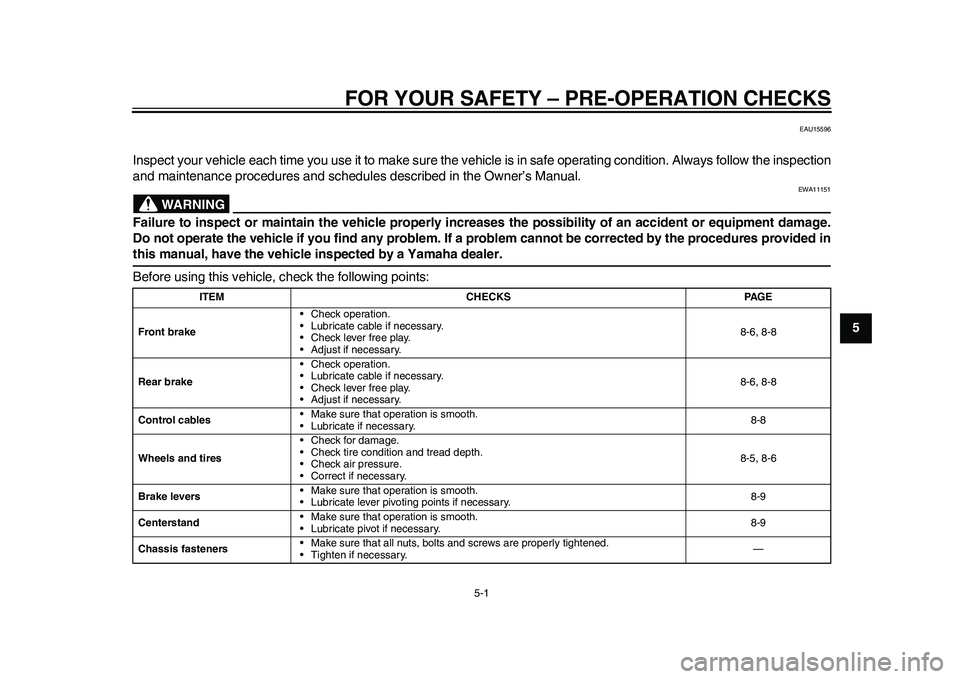
5-1
2
3
456
7
8
9
FOR YOUR SAFETY – PRE-OPERATION CHECKS
EAU15596
Inspect your vehicle each time you use it to make sure the vehicle is in safe operating condition. Always follow the inspection
and maintenance procedures and schedules described in the Owner’s Manual.
WARNING
EWA11151
Failure to inspect or maintain the vehicle properly increases the possibility of an accident or equipment damage.
Do not operate the vehicle if you find any problem. If a problem cannot be corrected by the procedures provided inthis manual, have the vehicle inspected by a Yamaha dealer.
Before using this vehicle, check the following points:
ITEM CHECKS PAGE
Front brake• Check operation.
• Lubricate cable if necessary.
• Check lever free play.
• Adjust if necessary.8-6, 8-8
Rear brake• Check operation.
• Lubricate cable if necessary.
• Check lever free play.
• Adjust if necessary.8-6, 8-8
Control cables• Make sure that operation is smooth.
• Lubricate if necessary.8-8
Wheels and tires• Check for damage.
• Check tire condition and tread depth.
• Check air pressure.
• Correct if necessary.8-5, 8-6
Brake levers• Make sure that operation is smooth.
• Lubricate lever pivoting points if necessary.8-9
Centerstand• Make sure that operation is smooth.
• Lubricate pivot if necessary.8-9
Chassis fasteners• Make sure that all nuts, bolts and screws are properly tightened.
• Tighten if necessary.—
1CB-9-E0.book 1 ページ 2010年10月15日 金曜日 午前10時19分
Page 35 of 78
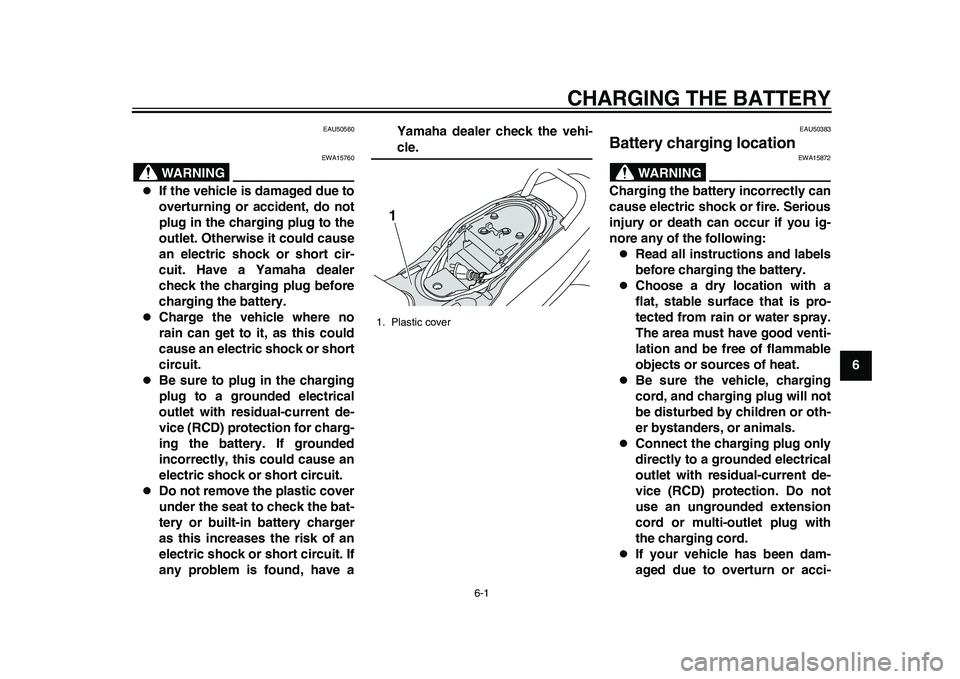
6-1
2
3
4
567
8
9
CHARGING THE BATTERY
EAU50560
WARNING
EWA15760
If the vehicle is damaged due to
overturning or accident, do not
plug in the charging plug to the
outlet. Otherwise it could cause
an electric shock or short cir-
cuit. Have a Yamaha dealer
check the charging plug before
charging the battery.
Charge the vehicle where no
rain can get to it, as this could
cause an electric shock or short
circuit.
Be sure to plug in the charging
plug to a grounded electrical
outlet with residual-current de-
vice (RCD) protection for charg-
ing the battery. If grounded
incorrectly, this could cause an
electric shock or short circuit.
Do not remove the plastic cover
under the seat to check the bat-
tery or built-in battery charger
as this increases the risk of an
electric shock or short circuit. If
any problem is found, have aYamaha dealer check the vehi-
cle.
EAU50383
Battery charging location
WARNING
EWA15872
Charging the battery incorrectly can
cause electric shock or fire. Serious
injury or death can occur if you ig-
nore any of the following:
Read all instructions and labels
before charging the battery.
Choose a dry location with a
flat, stable surface that is pro-
tected from rain or water spray.
The area must have good venti-
lation and be free of flammable
objects or sources of heat.
Be sure the vehicle, charging
cord, and charging plug will not
be disturbed by children or oth-
er bystanders, or animals.
Connect the charging plug only
directly to a grounded electrical
outlet with residual-current de-
vice (RCD) protection. Do not
use an ungrounded extension
cord or multi-outlet plug with
the charging cord.
If your vehicle has been dam-
aged due to overturn or acci-
1. Plastic cover1
1CB-9-E0.book 1 ページ 2010年10月15日 金曜日 午前10時19分
Page 37 of 78
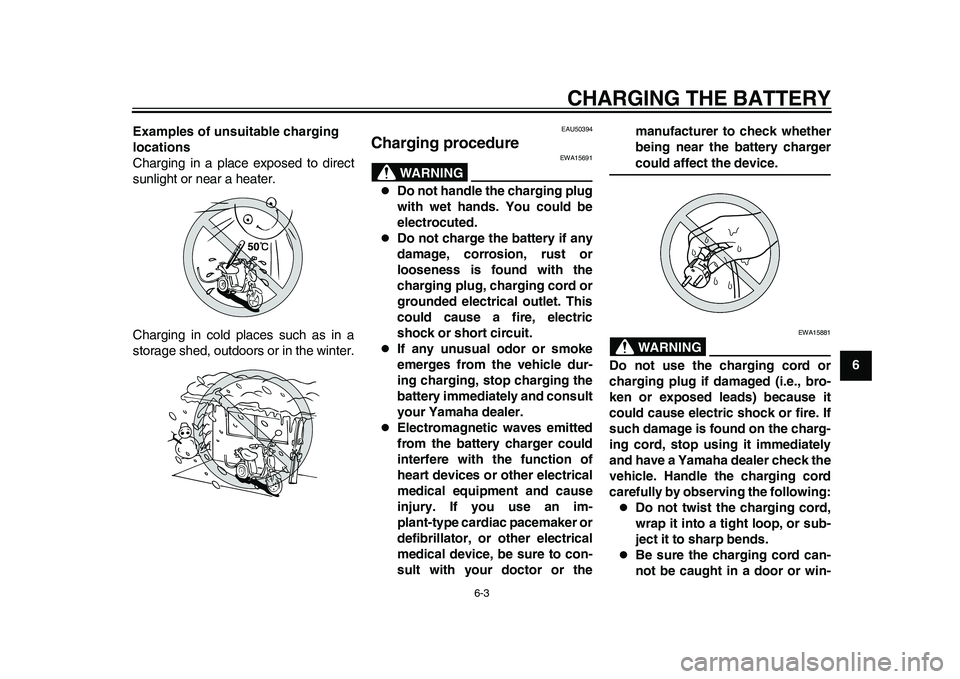
CHARGING THE BATTERY
6-3
2
3
4
567
8
9 Examples of unsuitable charging
locations
Charging in a place exposed to direct
sunlight or near a heater.
Charging in cold places such as in a
storage shed, outdoors or in the winter.
EAU50394
Charging procedure
WARNING
EWA15691
Do not handle the charging plug
with wet hands. You could be
electrocuted.
Do not charge the battery if any
damage, corrosion, rust or
looseness is found with the
charging plug, charging cord or
grounded electrical outlet. This
could cause a fire, electric
shock or short circuit.
If any unusual odor or smoke
emerges from the vehicle dur-
ing charging, stop charging the
battery immediately and consult
your Yamaha dealer.
Electromagnetic waves emitted
from the battery charger could
interfere with the function of
heart devices or other electrical
medical equipment and cause
injury. If you use an im-
plant-type cardiac pacemaker or
defibrillator, or other electrical
medical device, be sure to con-
sult with your doctor or themanufacturer to check whether
being near the battery charger
could affect the device.WARNING
EWA15881
Do not use the charging cord or
charging plug if damaged (i.e., bro-
ken or exposed leads) because it
could cause electric shock or fire. If
such damage is found on the charg-
ing cord, stop using it immediately
and have a Yamaha dealer check the
vehicle. Handle the charging cord
carefully by observing the following:
Do not twist the charging cord,
wrap it into a tight loop, or sub-
ject it to sharp bends.
Be sure the charging cord can-
not be caught in a door or win-
1CB-9-E0.book 3 ページ 2010年10月15日 金曜日 午前10時19分
Page 39 of 78

CHARGING THE BATTERY
6-5
2
3
4
567
8
9 6. Close the seat and push down on
the back to lock it in position.
TIPBefore closing the seat, make sure thatnothing is left under it.
7. Remove the key. To help prevent
theft, be sure to lock the steering,
and then remove the key when
charging the battery.
8. Inspect the charging plug for any
damage. Remove any dust, soil,
oil or water with a dry cloth if nec-
essary. Plug the charging plug into
a grounded electrical outlet with
residual-current device (RCD) pro-
tection.
WARNING
EWA15891
To avoid serious injury or death
from electric shock or fire:
Do not use the charging plug if it
has a damaged or loose prong.
Have a Yamaha dealer check the
vehicle.
Check the charging plug for any
foreign objects such as dust,
soil, oil or water before charg-
ing. If necessary, wipe the plug
clean with a dry cloth.
Do not use an ungrounded ex-
tension cord or a multi-outlet
plug between the charging cord
and the outlet.
Do not use the electrical outletalong with other electrical
equipment which may exceed
the outlet’s amperage and over-
heat the outlet.
Be sure to plug in the chargingplug firmly.
9. When the charging plug is plugged
into an electrical outlet, charging
starts automatically. The battery
1. Charging plug
1
1CB-9-E0.book 5 ページ 2010年10月15日 金曜日 午前10時19分
Page 42 of 78
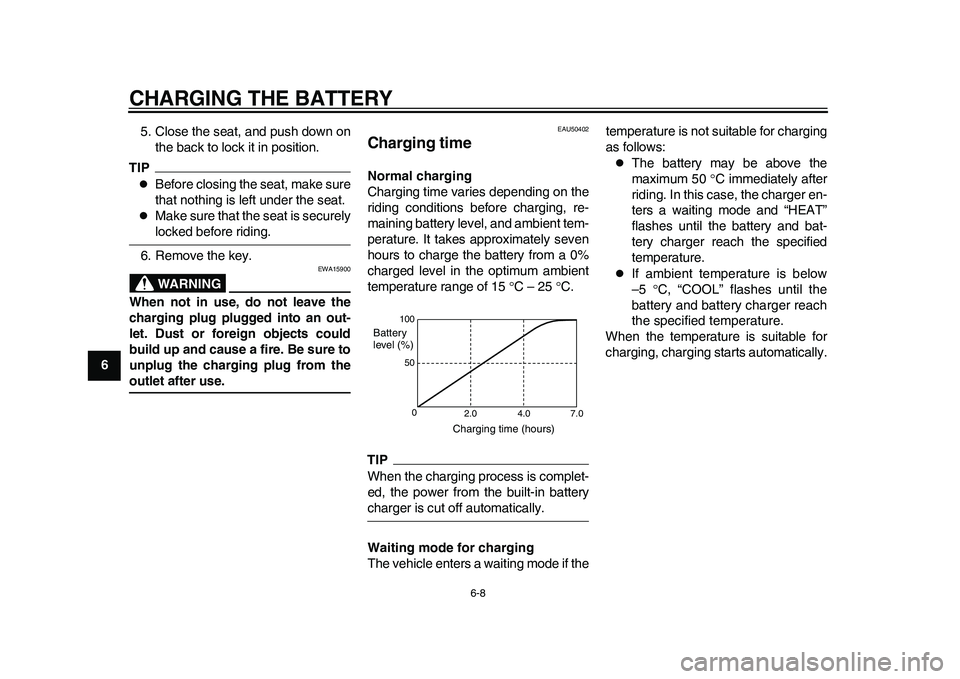
CHARGING THE BATTERY
6-8
1
2
3
4
56
7
8
95. Close the seat, and push down on
the back to lock it in position.
TIP
Before closing the seat, make sure
that nothing is left under the seat.
Make sure that the seat is securelylocked before riding.
6. Remove the key.WARNING
EWA15900
When not in use, do not leave the
charging plug plugged into an out-
let. Dust or foreign objects could
build up and cause a fire. Be sure to
unplug the charging plug from theoutlet after use.
EAU50402
Charging time Normal charging
Charging time varies depending on the
riding conditions before charging, re-
maining battery level, and ambient tem-
perature. It takes approximately seven
hours to charge the battery from a 0%
charged level in the optimum ambient
temperature range of 15 C – 25 C.TIPWhen the charging process is complet-
ed, the power from the built-in batterycharger is cut off automatically.
Waiting mode for charging
The vehicle enters a waiting mode if thetemperature is not suitable for charging
as follows:
The battery may be above the
maximum 50 C immediately after
riding. In this case, the charger en-
ters a waiting mode and “HEAT”
flashes until the battery and bat-
tery charger reach the specified
temperature.
If ambient temperature is below
–5 C, “COOL” flashes until the
battery and battery charger reach
the specified temperature.
When the temperature is suitable for
charging, charging starts automatically.
100
50
0
2.0 4.0 7.0
Charging time (hours) Battery
level (%)
1CB-9-E0.book 8 ページ 2010年10月15日 金曜日 午前10時19分
Page 45 of 78

7-1
2
3
4
5
678
9
OPERATION AND IMPORTANT RIDING POINTS
EAU15951
Read the Owner’s Manual carefully to
become familiar with all controls. If
there is a control or function you do not
understand, ask your Yamaha dealer.
WARNING
EWA10271
Failure to familiarize yourself with
the controls can lead to loss of con-
trol, which could cause an accidentor injury.
EAU50092
Preparations for starting off TIPMake sure the accelerator grip is
closed before starting off. An error
could occur if the accelerator grip isturned.
1. Stand on the left side of the vehi-
cle.
2. While pulling the rear brake lever
with your left hand and holding the
grab bar with your right hand, push
the vehicle off the centerstand.
WARNING
EWA15660
Before placing the vehicle on or
pushing it off the centerstand or sit-
ting on the seat, be sure the key is
“OFF”. Otherwise, the vehicle couldstart moving unexpectedly if the ac-
celerator grip is turned accidentally.
3. Put your right foot on the footrest,
and sit on the seat. At the same
time support the vehicle with your
left foot so that the vehicle does
not fall over.
4. Squeeze the rear brake with your
left hand to prevent the vehicle
from moving.
1CB-9-E0.book 1 ページ 2010年10月15日 金曜日 午前10時19分
Page 49 of 78
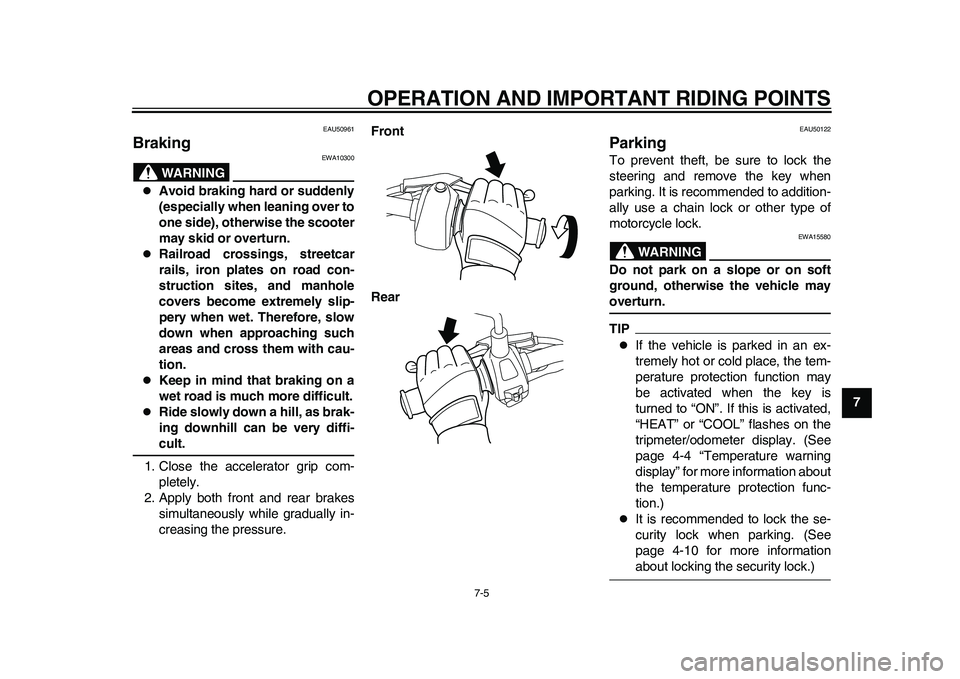
OPERATION AND IMPORTANT RIDING POINTS
7-5
2
3
4
5
678
9
EAU50961
Braking
WARNING
EWA10300
Avoid braking hard or suddenly
(especially when leaning over to
one side), otherwise the scooter
may skid or overturn.
Railroad crossings, streetcar
rails, iron plates on road con-
struction sites, and manhole
covers become extremely slip-
pery when wet. Therefore, slow
down when approaching such
areas and cross them with cau-
tion.
Keep in mind that braking on a
wet road is much more difficult.
Ride slowly down a hill, as brak-
ing downhill can be very diffi-cult.
1. Close the accelerator grip com-
pletely.
2. Apply both front and rear brakes
simultaneously while gradually in-
creasing the pressure.Front
Rear
EAU50122
Parking To prevent theft, be sure to lock the
steering and remove the key when
parking. It is recommended to addition-
ally use a chain lock or other type of
motorcycle lock.
WARNING
EWA15580
Do not park on a slope or on soft
ground, otherwise the vehicle mayoverturn.TIP
If the vehicle is parked in an ex-
tremely hot or cold place, the tem-
perature protection function may
be activated when the key is
turned to “ON”. If this is activated,
“HEAT” or “COOL” flashes on the
tripmeter/odometer display. (See
page 4-4 “Temperature warning
display” for more information about
the temperature protection func-
tion.)
It is recommended to lock the se-
curity lock when parking. (See
page 4-10 for more informationabout locking the security lock.)
1CB-9-E0.book 5 ページ 2010年10月15日 金曜日 午前10時19分
Page 50 of 78

8-1
1
2
3
4
5
6
78
9
PERIODIC MAINTENANCE AND ADJUSTMENT
EAU50130
Periodic inspection, adjustment, and lu-
brication will keep your vehicle in the
safest and most efficient condition pos-
sible. Safety is an obligation of the vehi-
cle owner/operator. The most important
points of vehicle inspection, adjust-
ment, and lubrication are explained on
the following pages.
The intervals given in the periodic
maintenance charts should be simply
considered as a general guide under
normal riding conditions. However, de-
pending on the weather, terrain, geo-
graphical location, and individual use,
the maintenance intervals may need to
be shortened.
WARNING
EWA10321
Failure to properly maintain the ve-
hicle or performing maintenance ac-
tivities incorrectly may increase
your risk of injury or death during
service or while using the vehicle. If
you are not familiar with vehicle ser-
vice, have a Yamaha dealer performservice.
WARNING
EWA15840
Turn the key to “OFF” when per-
forming maintenance unless other-
wise specified. A running motor has
moving parts that can catch on body
parts or clothing and electrical partsthat can cause shocks or fires.
WARNING
EWA15830
This scooter is designed for use onpaved roads only.
WARNING
EWA15460
Brake discs, calipers, drums, and
linings can become very hot during
use. To avoid possible burns, let
brake components cool beforetouching them.
1CB-9-E0.book 1 ページ 2010年10月15日 金曜日 午前10時19分